This article has been reviewed according to Science X's editorial process and policies. Editors have highlighted the following attributes while ensuring the content's credibility:
fact-checked
peer-reviewed publication
trusted source
proofread
Scientists develop a new model for understanding sudden death in epilepsy

Researchers at the University of Michigan have developed a model for studying one type of familial epilepsy, opening the door to understanding—and eventually targeting—the mechanisms that lead to the disorder and its associated fatalities.
The research, published in the journal Annals of Neurology, has already revealed important insights into interactions between breathing, heart rate and brain activity during fatal seizures.
Mutations in a gene called DEPDC5 are a common cause of familial focal epilepsy and increase the risk of sudden unexpected death in epilepsy (SUDEP), a devastating consequence of epilepsy that ranks second only to stroke in potential life-years lost due to neurological diseases. But scientists have been unable to determine the underlying processes that lead to SUDEP in DEPDC5-related epilepsy.
"Without a clear understanding of the precise mechanisms that drive SUDEP, it is extremely difficult to predict its occurrence in patients," said Yu Wang, associate professor of neurology at the U-M Medical School who also works with epilepsy patients at Michigan Medicine. "Having an accurate model that we can study at the molecular level is essential for understanding the complex pathophysiology of this condition and identifying therapeutic targets."
Model organisms are an important tool for gaining insights into human health and disease that have significant implications for treating patients. By understanding how a genetic mutation alters activities within cells, or even communications between various systems in the body, researchers can uncover specific proteins to target with therapeutics, for example. To date, however, the field lacked an accurate animal model of DEPDC5-related epilepsy.
Now, a team led by Wang and U-M neuroscientist Peng Li has accurately recapitulated a model of DEPDC5-related epilepsy in a mammalian model organism, allowing researchers to better understand what takes place within patients with DEPDC5-related epilepsy and what leads to their increased risk of SUDEP.
"This genetic model offers us a way to further check what is causing the physical changes that take place before SUDEP, and what is causing the epilepsy," said Li, a faculty member at the U-M Life Sciences Institute and assistant professor of molecular and integrative physiology at the U-M Medical School. "It will help us to really zero in on the cell types that are affected and then to figure out—and ultimately target—the molecular pathways causing these changes."
With the model, the team has identified a unique pattern in DEPDC5-related fatal seizures.
It starts with breath
Once they determined that the animals were closely recapitulating the characteristics found in humans with DEPDC5-related epilepsy—including the type and frequency of seizures and the approximate age when SUDEP occurs on average—the researchers began to record data on their breathing patterns, cardiac function and neuronal activity. Their goal was to gather baseline information about the animals' health, as well as to observe how these functions change during naturally occurring seizures.
In instances of fatal seizures, the animals' breathing rate increased significantly, even before changes in heart rate or the brain's electrical activity, and then stopped completely. When the seizures ended, the heart rate resumed—but breathing ceased completely and never recovered, leading to a fatal lack of oxygen.
The researchers also found breathing irregularities during nonfatal seizures, and even in the animals' baseline breathing rates. The team believes these results point to a defect in the brain's breathing control circuit that makes the animals more vulnerable during seizures, which could contribute to the increased rate of SUDEP in DEPDC5-related epilepsy.
"It appears breathing is the first physiological function being affected in epilepsy, even before we can detect any changes in electrical activity in the brain," said Li, who is also an assistant professor of biologic and materials sciences at the U-M School of Dentistry. "These findings hint at both a potential treatment—ventilating the animals during an epilepsy episode to rescue breathing—and a potential biomarker for predicting the risk of epilepsy patients who may develop SUDEP."
Jack Parent, co-director of the Michigan Medicine Comprehensive Epilepsy Center and one of the study's co-authors said that SUDEP is the epilepsy complication most feared by patients and families.
"This work offers them some hope that the epilepsy research field is making progress towards understanding SUDEP mechanisms, identifying potential biomarkers for those at risk, and devising interventions to prevent these catastrophic events," he said.
More information: Hsin‐Yi Kao et al, Sudden Unexpected Death in Epilepsy and Respiratory Defects in a Mouse Model of DEPDC5‐Related Epilepsy, Annals of Neurology (2023). DOI: 10.1002/ana.26773


















